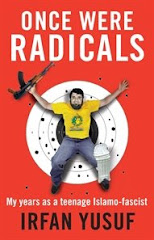Today I attended the Hizb ut-Tahrir conference in Lakemba. I was there covering the event for an online publication I write for on a regular basis. Among the people I saw there was a familiar face I also saw at a recent forum I attended where I shared a podium with Danny Nalliah from the Catch The Fire Ministries.
That familiar face was Terry Baldwin, a middle-aged chap with a small beard and jovial appearance. Baldwin attends a number of events related to Islam and Muslims, and takes a strong interest in Muslim affairs.
I have also seen Mr Baldwin at the Journalist and Islam conference organised by the Middle East Centre of Macquarie University. There, Baldwin boasted that he had recorded the speeches of a number of Muslim speakers and handed them to journalists. In particular, he admitted to forwarding a recording of Sheik Feiz Mohammad’s infamous 2005 lecture where he suggested women who dressed a certain way are eligible for rape.
Baldwin’s own expressed views on Islam are quite jaundiced to say the least. He believes Islam is an inherently violent faith. At the Journalism and Islam conference, he had a verbal altercation with a speaker who claimed Muslims as a whole had peaceful intentions which arose from their theology.
I took the opportunity of sitting down with Mr Baldwin today at the HT conference and finding out more about his activities. Baldwin was surprisingly cagey, especially when I asked about his dealings with The Age’s religious affairs writer Barney Zwartz.
Mr Zwartz recent cited Baldwin in a recent write-up of the HT in Australia:
Sydney Islam-watcher Terry Baldwin says the history HT presents of the West and Islam is simply fantasy. "It's not just a little bit wrong, it's grossly wrong: 'Your (Western) history was violence and oppression whereas ours (Islam's) was wonderful, and if you go back to that we can solve your problems as well as ours.' " Baldwin says the Doureihi brothers, Ashraf and Wassim, seem to lead the group, "but you can never be sure of that. In many groups there are gnomes in the background who pull all the strings and control the finances."
He does worry about HT's attempts to politicise Australian Muslims, to drive a wedge between them and the wider community. Many Muslims come to Australia to escape trouble and simply want to build a better life, he says, but HT wants them involved in the politics. "They go house to house around my neighbourhood and ask: 'Do you know any Muslims in your street. We have a new mosque and we want to tell them.' Then they try to recruit them."
I’m not sure what makes Baldwin an "Islam-watcher" apart from the fact that he attends many events and records them. Certainly this is his right. Further, it is clear that he has some kind of relationship with at least 2 journalists.
However, one wonders of the quality of information Baldwin gives to the reporters and columnists he deals with. His own expressed views on Islam resemble something out of JihadWatch. More importantly, one wonders about his ability to identify different Muslim groups.
For instance, Baldwin’s claim that HT goes around door knocking and inviting people to the mosque to hear a talk sounds absurd. My own experience with HT (spanning over a decade) is that HT would never use such methodology. Rather, this methodology is largely the trademark of the Tabligh Jamaah, an Indian-based Sufi missionary movement.
It therefore surprises me that someone like Zwartz would quote someone who, it seems to me, is clearly not a knowledgeable or credible source. I’m particularly concerned about Baldwin’s insistence on being so cagey about his dealings with journalists at some times, whilst at other times boasting of recording and “leaking” (to use the term he used at the Journalism and Islam conference) material to scribes.
Still, it’s obvious we will be seeing more of Baldwin over the coming months. He is a pleasant chap, and I hope Muslim groups continue to show him the hospitality HT showed him today.
© Irfan Yusuf 2007










